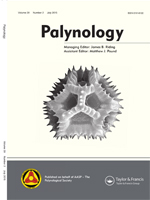Although abundant palaeontological discoveries have been documented in the Daohugou area in Chifeng City, Inner Mongolia, China, no record of the palynoflora has been reported previously. We collected palynological samples from the same level as megafossil plants, and conducted a detailed taxonomic analysis of the pollen and spores in order to augment the megafossil record, to extend documentation of the Middle Jurassic palynoflora, and to examine implications for palaeogeography, palaeoecology and palaeoclimate in north China during the Jurassic. Forty-four genera and 87 species of palynomorphs were identified. Pollen of gymnosperms dominates numerically, followed by spores of pteridophytes. Most taxa, including bisaccate pollen of conifers, monosulcate pollen of Cycadales, Bennettitales or Ginkgoales, along with Cyathidites, Deltoidospora, Granulatisporites, Osmundacidites and Classopollis, are common elements known elsewhere during the Jurassic. Based on comparisons with similar palyno-assemblages in the Jurassic of China, the age of the Daohugou locality is interpreted to be late Middle Jurassic. According to the palaeobotanical and palaeopalynological information, the Daohugou flora is attributed to the warm-temperate to medium temperate zone with seasonal change. By studying the ecological and climatic preferences of the main plant groups, five types of palaeolandscape in the Jurassic of Daohugou are proposed: (1) mesic upland (Pinaceae, Podocarpaceae, Czekanowskiales and Bennettitales), (2) mesic lowland (Pinaceae, Podocarpaceae, Ginkgoales, Czekanowskiales and Cycadales, together with some hygrophilous bryophytes, lycophytes and ferns), (3) dry upland (Czekanowskiales), (4) dry lowland (Czekanowskiales and Cheirolepidiaceae) and (5) waterside (plants growing along streams or near lakes, including bryophytes, lycophytes, ferns and probably some pteridosperms). According to the plant assemblage, the Daohugou flora corresponds to that of the Middle Jurassic Northern Floristic Province of China, which experienced a transition from a humid, warm climate to a hotter climate with seasonal drought.
How to translate text using browser tools
1 July 2015
The Middle Jurassic Palynology of the Daohugou Area, Inner Mongolia, China, and Its Implications for Palaeobiology and Palaeogeography
Yuling Na,
Steven R. Manchester,
Chunlin Sun,
Shuqin Zhang
ACCESS THE FULL ARTICLE
It is not available for individual sale.
This article is only available to subscribers.
It is not available for individual sale.
It is not available for individual sale.
<
Previous Article
|

Palynology
Vol. 39 • No. 2
July 2015
Vol. 39 • No. 2
July 2015
China
Daohugou
inner Mongolia
Middle Jurassic
Palaeobiology
palaeogeography
palynology




